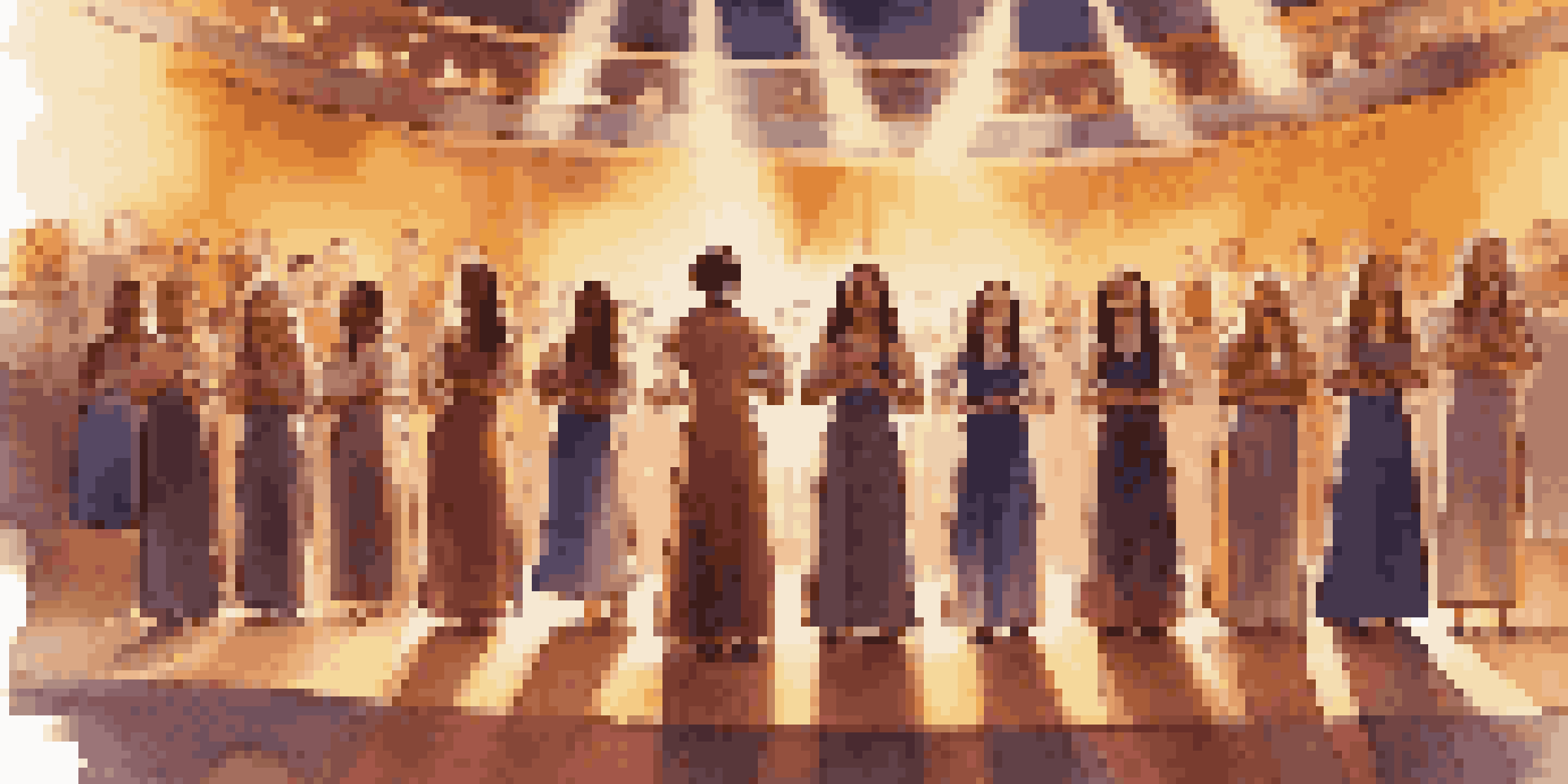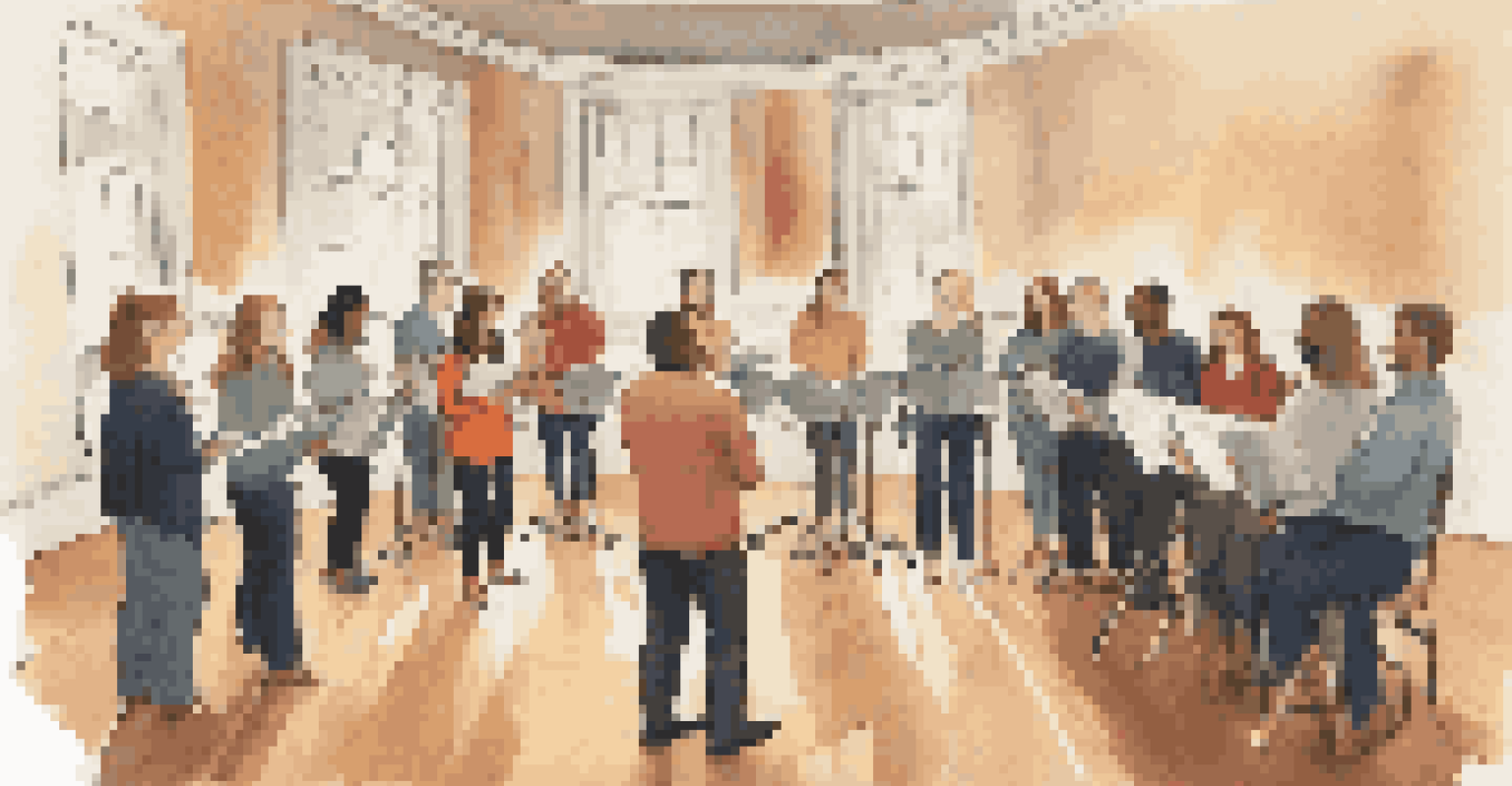Exploring A Cappella Choirs: Techniques and Challenges

Understanding the Essence of A Cappella Singing
A cappella singing, which means 'in the manner of the chapel,' refers to vocal music performed without instrumental accompaniment. This unique style allows singers to explore harmony and melody using only their voices, creating a rich, textured sound. Think of it as a vocal orchestra where each singer plays their part, from melody to bass lines, showcasing the versatility of human voice.
Music can change the world because it can change people.
The beauty of a cappella lies in its ability to evoke emotion and tell stories solely through voice. Each performance can be a fresh interpretation, as singers experiment with different arrangements and styles. This adaptability is what draws many to the art form, making every choir distinct in its sound and presentation.
However, mastering the a cappella style requires practice and a deep understanding of vocal techniques. Singers must develop strong pitch control and blend harmoniously with their peers, which can be quite challenging. This balance of individual expression and collective sound is what makes a cappella a rewarding yet complex endeavor.
Essential Techniques for A Cappella Performances
A cappella choirs utilize various vocal techniques to enhance their performances. Techniques such as vocal layering, where singers build harmonies on top of one another, create a fuller sound. Additionally, singers often employ beatboxing or vocal percussion, adding rhythmic elements that mimic instruments, making the performance feel more dynamic and engaging.

Another key technique is the use of dynamics and articulation. Singers learn to vary their volume and intensity to emphasize certain parts of a song, creating a captivating listening experience. This not only showcases their vocal range but also keeps the audience engaged throughout the performance.
A Cappella Enhances Vocal Skills
A cappella singing fosters strong pitch control, harmony blending, and dynamic performance techniques among singers.
It's essential for choir members to develop strong listening skills, as a cappella relies heavily on each singer's ability to hear and adapt to others. This collaborative environment fosters a sense of community within the choir, encouraging singers to support and challenge one another to reach new heights.
Navigating the Challenges of A Cappella Singing
One of the primary challenges choirs face is achieving perfect pitch and harmony. Without instrumental support, singers must rely on their ears and internalize the music. This can be daunting, especially for novice singers who may struggle with tuning and blending with the group.
The only thing better than singing is more singing.
Moreover, maintaining rhythm and timing is crucial in a cappella performances. Since there are no instruments to keep time, singers must be attentive to each other, creating a synchronized sound. Rehearsing together regularly helps develop this skill, but it requires dedication and teamwork from all members.
Finally, arranging music for a cappella can be a complex task. Choosing the right songs and adapting them for vocal performance demands creativity and skill. Many choirs face the challenge of finding or creating arrangements that highlight their unique strengths while ensuring an appealing experience for the audience.
The Role of Arrangements in A Cappella Choirs
Arrangements are the backbone of a cappella performances, transforming songs into vocal masterpieces. A well-crafted arrangement takes into account the strengths of each singer, ensuring that everyone contributes to the overall sound. This process often involves careful consideration of vocal ranges and harmonies to create a balanced performance.
Moreover, arrangements can vary significantly, from simple harmonizations to complex polyphonic structures. This diversity allows choirs to explore different musical genres and styles, broadening their repertoire and appeal. It’s fascinating how a single song can take on a completely new character through creative arranging.
Community Strengthens Choir Bonds
Building a cohesive choir community through collaboration and social activities enhances overall performance and creativity.
Collaborating on arrangements also fosters creativity within the choir. Singers are encouraged to share their ideas and experiment, leading to innovative interpretations of familiar pieces. This creative process not only enhances the performance but also strengthens the bond among choir members.
Building a Cohesive Choir Community
A cappella choirs thrive on camaraderie and collaboration, making it essential to cultivate a strong community. Regular rehearsals and social events help members bond, creating a supportive environment where everyone feels valued. This sense of belonging is crucial for fostering a positive atmosphere that encourages growth and creativity.
Furthermore, engaging in team-building activities can enhance the choir's overall performance. These activities not only strengthen relationships but also improve communication skills, which are vital for successful a cappella singing. When choir members trust and understand each other, they can perform with greater confidence and cohesion.
Ultimately, a supportive community allows singers to take risks and explore their musical abilities. It transforms the choir into a safe space for artistic expression, where each member feels empowered to shine while contributing to the collective sound.
The Impact of Technology on A Cappella Choirs
In an age of digital innovation, technology plays a significant role in the evolution of a cappella choirs. From recording software to social media, technology enhances the way choirs create, share, and promote their music. Singers can now record their performances at home, allowing for greater flexibility and accessibility in the rehearsal process.
Social media platforms provide choirs with an opportunity to reach a wider audience. By sharing videos and performances online, choirs can showcase their talent and attract new members. This digital presence not only boosts visibility but also fosters a sense of connection with fans and the broader musical community.
Technology Transforms A Cappella
Digital tools and social media broaden the reach and collaboration opportunities for a cappella choirs, enriching their musical experience.
Additionally, technology enables choirs to collaborate with other musicians around the globe. Virtual rehearsals and online workshops create opportunities for learning and sharing ideas, enriching the choir experience. Embracing technology allows a cappella choirs to thrive in a rapidly changing musical landscape.
Celebrating the Joy of A Cappella Performance
At its core, a cappella singing is about celebrating the joy of music and human connection. Each performance is an opportunity for singers to share their passion and creativity with the audience, forging a unique bond through the shared experience of song. This sense of joy resonates not only with the performers but also with listeners, creating lasting memories.
The thrill of harmonizing with others and the satisfaction of perfecting a piece can be incredibly rewarding. Many choir members find that the challenges they face only enhance their appreciation for the art form. The journey of growth, both individually and collectively, is what makes a cappella so special.

Ultimately, a cappella choirs serve as a reminder of the power of music to bring people together. Whether it’s through uplifting performances or heartfelt arrangements, the joy of a cappella singing continues to inspire and connect individuals across diverse backgrounds.